Union State
Union State
| |
|---|---|
.svg.png) | |
| Headquarters | Staraya Square, Moscow[1] |
| Largest city |
Moscow 55°45′N 37°37′E / 55.750°N 37.617°E |
| Official languages | |
| Type |
Supranational union (de jure) Confederation (de facto) |
| Member states | |
| Leaders | |
• Chairman of the Supreme State Council |
|
• Chairman of the Council of Ministers |
|
• General Secretary |
|
| Legislature | Supreme State Council |
| Area | |
• Total | 17,332,837 km2 (6,692,246 sq mi)a |
| Population | |
• 2016 estimate | 156 milliona |
• Density | 9.0/km2 (23.3/sq mi) |
| HDI (2015) |
very high |
| Currency | |
| Time zone | UTC+2 to +12 |
| Date format | dd.mm.yyyy |
| Driving side | right |
|
Website www | |
| |
The Union State (Russian: Сою́зное госуда́рство, IPA: [sɐˈjuznəjə ɡəsʊˈdarstvə]; Belarusian: Саюзная дзяржава Sajuznaja dziaržava), also referred to as the Union State of Russia and Belarus (Russian: Сою́зное Госуда́рство Росси́и и Беларуси, IPA: [sɐˈjuznəjə ɡəsʊˈdarstvə rɐˈsʲiɪ i bʲɪləˈrusʲɪ]; Belarusian: Саюзная дзяржава Расіі і Беларусі), is a supranational union consisting of the Russian Federation and the Republic of Belarus.
Formation
The Commonwealth of Belarus and Russia was founded on 2 April 1996.[2] The basis of the union was strengthened on 2 April 1997, with the signing of the "Treaty on the Union between Belarus and Russia" at which time its name was changed to the Union of Belarus and Russia.[3] Several further agreements were signed on 25 December 1998, with the intention of providing greater political, economic, and social integration.[3]
Nevertheless, the nature of the political entity remained vague. Under pressure from his own political opponents, who argued for a reunion of the two states, and from Belarusian President Alexander Lukashenko, who sought to tie his excessively weak economy to Russia's stronger one, then Russian President Boris Yeltsin initiated the creation of the Union in order to harmonize the political and economic differences between the two nations.[4] Kazakh President Nursultan Nazarbayev had put forward a similar proposal in 1994, envisioning the founding of a Eurasian union, but this proposal was not adopted until 29 May 2014 with the formation of the Eurasian Economic Union.[5] The Treaty on the Creation of a Union State of Russia and Belarus was signed on 8 December 1999.[6] The intention was to achieve a federation like the Soviet Union, with a common head of state, legislature, flag, coat of arms, anthem, constitution, army, citizenship, and currency. The Union was ratified by the Russian State Duma on 22 December 1999 and the National Assembly of Belarus on 26 January 2000. On the latter date the Treaty and the Union came into effect.[7]
Institutions and legal framework

The Treaty on the Creation of a Union State has established the following institutions:[8]
- A Supreme State Council, the highest authority in the Union State, made up of the Presidents, Prime Ministers and the heads of both chambers of the Parliaments of both countries. Each state has one vote in the Council, meaning effectively that all decisions must be unanimous.
- A Council of Ministers, composed of the member states' Prime Ministers, Ministers of Foreign Affairs, Economy, and Finance and the State Secretary of the Union.
- A bicameral Union Parliament, comprising an elected House of Representatives, which contains 75 deputies from Russia and 28 from Belarus, elected by the general populace of each, and a House of the Union with an equal number of deputies (36) from each nation selected by their respective upper legislative houses. The Union Parliament has never been put into effect.
- A Court of the Union, consisting of nine judges appointed for six-year terms. The Court of the Union was never established.
- A House of Audit or Accounting Chamber, controlling the implementation of the budget.
Each member state retains its own sovereignty and international personality, meaning that Russia and Belarus are still fully responsible for their own internal affairs and external relations. The Union State cannot claim representation in other international organizations or overrule legislation or government decisions of its member states, except in cases specified by the Union Treaty. As such, the Union State most resembles a supranational confederation on the order of the African Union, or the Union of South American Nations.
Pavel Borodin is the State Secretary of the Union. He was first appointed by the Supreme State Council on January 26, 2000 for a four-year term. In 2004 and 2008 his term was renewed for an additional four years.
Developments
Shortly after its inauguration, both member states seemed to have lost their enthusiasm for the Union, with first Russia, and then Belarus, restoring customs controls along their common border in 2001, effectively suspending the customs union until it was restored in 2010. Plans had also been set in motion to implement a common currency across the Union, but these have been postponed several times.
Additionally, Belarus and Russia have thus far failed to institute any symbols or even a flag for the Union State.[9][10] Nevertheless, a song called "Sovereign Union of Nations" (Russian: Державный союз народов Derzhavny soyuz narodov, Belarusian: Дзяржаўны саюз народаў Dzyarzhauny sayuz narodau) has been proposed as the Union's unofficial anthem. The song, which was modified from the National Anthem of the Soviet Union, refers to a wider union of the two nations.[11]
On November 16, 2010, it was announced by the Union State website that the Constitutional Act was 99% ready.[12]
Common currency
Belarusian President Alexander Lukashenko promised to introduce a common currency on 1 January 2004. The currency was not introduced, and the plan was pushed back by one year. On 1 January 2005, the Union State again failed to introduce a common currency, and it was again postponed by one year, which, in 2006, happened once again. During a press-conference in Minsk on 2 February 2006, Pyotr Prokopovich, chief of the National Bank of Belarus, announced that a "common currency might be introduced in 2007". This, however, failed to occur in 2007. The National Bank of the Republic of Belarus announced that, starting in 2008, the Belarusian ruble would be tied to the United States dollar instead of the Russian ruble.[13]
Citizenship and freedom of migration
Despite lacking elaborate legal fundamentals indispensable for a union of such a degree of integration, and constant friction on a number of trade and political issues, the Union State does provide citizens of Russia and Belarus the right to work and permanently settle in either country without formal immigration procedures otherwise mandatory for foreign nationals. They retain their national passports and other identification papers.
Military
On 10 February 2009, Russia and Belarus implemented the first stage of joint military officer training programs designed to integrate the military structures of the countries. This military collective is called the Regional Forces Group of Belarus and Russia (RGF). The goal of these operations is to ensure cohesive training, practice and implementation of military interests for the nations, and were aimed at strategic and battle training taking place in February and March 2009.[14] Furthermore, the military doctrine of the Russian Federation provides that "an armed attack on the state-participant in the Union State, as well as all other actions involving the use of military force against it," should be deemed "an act of aggression against the Union State", authorizing Moscow to "take measures in response".[15]
Flag and coat of arms
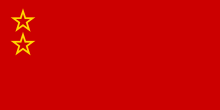
Since the formation of the Union of Russia and Belarus in 1997, there has not been official recognition of a state flag or coat of arms. There have been several drafts for flags and coats of arms.
Two proposals have been made for the flag of the Union. In all cases, they are modifications to the flag of the Soviet Union, but representing the state (not communism). In both cases, two gold stars are placed in the canton of the red flag (to represent the two states of the Union).[10]
A proposed coat of arms is a modification of the double-headed eagle holding the coats of arms of Russia and Belarus.[16]
Value added tax controversy
Belarus and Russia had been collecting a value added tax (VAT), meant to finance the Union State, in the country of origin, but from 1 January 2005, VAT is collected in the country of destination, as in most other independent countries of the world. This change gave rise to a considerable degree of confusion and has disrupted many trade operations between Belarus and Russia. On 10 February 2005, private entrepreneurs in Belarus staged a one-day warning strike, protesting the new VAT scheme between the two countries and Lukashenko's economic policies.
Contemplated expansion
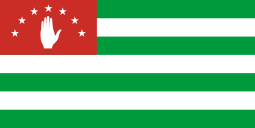
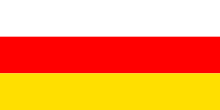
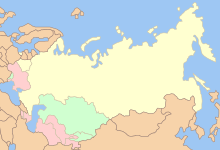

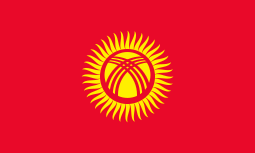

.svg.png)

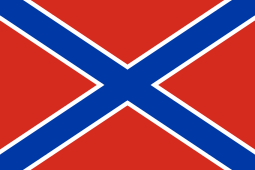
Renewed interest
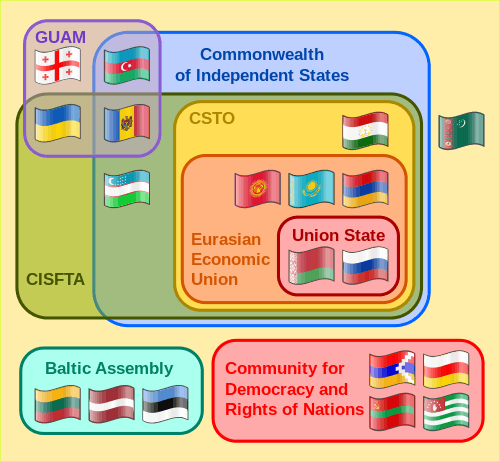
On 15 December 2006, talks over the Union State were heating up.[29] By January 2007, however, talks appeared to be stalled, as President Alexander Lukashenko of Belarus stated: "The Russian leadership is demanding that we join the Russian Federation—that's what is in the heads of the Russian leadership. I don't want to bury the sovereignty and independence of [Belarus]." He added: "From all the consultations and discussions, I have understood that we have different approaches and understandings of the building of a union state", and opposed "the possibility of the incorporation into Russia [of Belarus]".[30]
However, on 19 October 2007, Russian Prime Minister Viktor Zubkov announced that the budget of the Union State "will grow by no less than ten percent next year, and that growth will provide for worthy funding of our common projects." [31] This has led to speculation that the Russian government have renewed their interest in the idea.
A meeting between President Lukashenko of Belarus, President Vladimir Putin of Russia and Union State Secretary Pavel Borodin was held in Minsk 13–14 December 2007. This meeting received a considerable amount of media attention and raised speculation that a Union State might indeed be the focus of a new initiative by both governments. Of primary interest was renewed discussion of the Union Parliament (which, although planned, was never actually realized) and a Union State Constitutional Act, an instrument which could strengthen the authority of the Union. According to State Secretary Borodin, five variants of this Act were discussed at the meeting, each of which would involve a 7 to 10 year transitional period in the Union's development. Trade and energy issues were also discussed.[32]
On 27 May 2008, President Lukashenko, acting in his capacity as Chairman of the Supreme State Council named then Russian Prime Minister and current President Putin Chairman of the Council of Ministers.[33] This move raised speculation that the Union was about to undergo a significant political transformation. However, the most visible and arguably important official in the Union has been the State Secretary, who runs the Union State's day-to-day operations. In the same meeting, State Secretary Borodin announced that the 2009 Union State budget would total 6–7 billion Russian rubles, an increase of over 2 billion rubles from 2008.
On 1 August 2011, Putin stated he supported a union of Russia, Belarus, and possibly South Ossetia.[34] Belarusian Foreign Minister spokesman Andrei Savinykh rejected the idea,[35] as did Dmitri Medojev, South Ossetia's ambassador to Moscow, who stated "Our people voted for independence in a referendum in 2006 and they do not relish the idea of becoming part of the Russian Federation."[35]
Since 2015, focus on developing relations between former members of the Soviet Union is on continued development of the Eurasian Economic Union (EAEU), itself a further development of the Eurasian Customs Union established in 2010. It is modeled on the integration of the European Union and comprises 5 member states: Belarus, Russia, Kazakhstan, Armenia and Kyrgyzstan. Tajikistan has also expressed an interest in joining. However, the EAEU is only an economic union, and at present, political integration remains within the remit of the Union State.
See also
- Commonwealth of Independent States
- Continental union
- 2007 Russia–Belarus energy dispute
- Post-Soviet states
- Soviet Union
- Union of Sovereign States
- Belarus–Russia relations
- Eurasian Economic Union
- Common Travel Area, an arrangement allowing for relatively open borders between the UK and the Republic of Ireland
- 1950 Indo-Nepal Treaty of Peace and Friendship
- European Single Market, a similar zone within the EU
References
- ↑ "Постоянный Комитет Союзного государства". www.postkomsg.com.
- ↑ Zulys, Audrius. "Toward a Union State of Russia and Belarus". Lithuanian Foreign Policy Review, 2005, p. 149
- 1 2 Ltd., ICB - InterConsult Bulgaria. "CEEOL - Error". www.ceeol.com.
- ↑ "Boris Yeltsin's Legacy". www.personal.utulsa.edu.
- ↑ Asadova, Nargiz. "An interview with Prime Minister of Kazakhstan Karim Masimov". Originally printed in Kommersant, 4 June 2007, p. 2. Translated by Ferghana.Ru "Archived copy". Archived from the original on June 5, 2008. Retrieved May 28, 2008.
- ↑ "BBC News - EUROPE - Russia and Belarus form confederation". news.bbc.co.uk.
- ↑ Zulys, Audrius. "Toward a Union State of Russia and Belarus", p. 151
- ↑ Ltd., ICB - InterConsult Bulgaria. "CEEOL - Error". www.ceeol.com.
- ↑ Геральдика.ру. "Проект герба Союза России и Белоруссии (2002 г.) - Геральдика.ру". geraldika.ru.
- 1 2 "флаги союза РФ и РБ". www.vexillographia.ru.
- ↑ ДЕРЖАВНЫЙ СОЮЗ НАРОДОВ (in Russian). 2003. Retrieved 2008-02-22.
- ↑ "Archived copy". Archived from the original on July 6, 2011. Retrieved November 22, 2010.
- ↑ "Belarus to link currency to dollar". Associated Press. 2007-08-15. Archived from the original on 22 April 2008. Retrieved 2007-10-01.
- ↑ "Link to joint military training". Union State Website. February 11, 2009. Archived from the original on August 14, 2009. Retrieved February 21, 2009.
- ↑ "Union State of Russia and Belarus: a military union?". Window on Heartland. January 14, 2012. Archived from the original on January 8, 2016.
- ↑ Проект герба Союза России и Белоруссии (2002 г.). Geraldika.ru (in Russian). Retrieved 2008-10-27.
- ↑ Sputnik. "Belarus could recognize Abkhazia, S.Ossetia next year". en.rian.ru.
- ↑ Abkhaz wish to join Union on YouTube
- 1 2 Customs Union of Belarus, Russia, Kazakhstan to be up and running by 2010 "Archived copy". Archived from the original on March 15, 2012. Retrieved July 31, 2007.
- ↑ "Trend - Новости Азербайджана. Турция, Иран, Центральна Азия". news.trendaz.com.
- ↑ "Moldova ready for Russia Belarus union". 17 April 2001 – via news.bbc.co.uk.
- ↑ Communists of Moldova and the future of the country's ethno-political conflicts "Archived copy" (PDF). Archived from the original (PDF) on August 19, 2007. Retrieved July 31, 2007.
- ↑ "That same year, the Tiraspol Supreme Soviet chairman declared that the Transnistrian republic will demand that Moldova accepts full integration into the CIS and that it joins the Russian Federation–Belarus union, viewed as a possible future model for the MTR's status vis-a-vis the Republic of Moldova. A non-binding referendum on joining the Russia-Belarus union was held between April and June 1998, with over 66 percent of the ballots supporting the union. However, like the province of Kaliningrad on the Baltic Sea (isolated from Russia by independent Lithuania and Poland), the east-bank separatist region, has no common borders with either Belarus or the Russian Federation." Moldova.org Official website of the Trades Ministry of the Republic of Moldova Archived December 20, 2008, at the Wayback Machine.
- ↑ President makes statement regarding debates over idea of so-called union of Ukraine, Russia and Belarus Archived March 20, 2012, at the Wayback Machine. April 1, 2010; Опыты независимой аналитики КУДА ИДЕМ МЫ С ЯНУКОВИЧЕМ? Archived March 15, 2012, at the Wayback Machine. Центр проблемного анализа и государственно-управленческого проектирования, April 9, 2010.
- ↑ "Теміргалієв оголосив про швидке створення "Української Федерації"" [Temirgaliyev announced the imminent creation of the "Ukrainian Federation"]. Ukrayinska Pravda. 12 April 2014.
- ↑ "Russian-backed 'Novorossiya' breakaway movement collapses". Ukraine Today. 20 May 2015.
- ↑ Vladimir Dergachev; Dmitriy Kirillov (20 May 2015). Проект «Новороссия» закрыт [Project "New Russia" is closed]. Gazeta.ru (in Russian).
- ↑ "Why the Kremlin Is Shutting Down the Novorossiya Project". Carnegie Endowment for International Peace. Retrieved 2015-12-20.
- ↑ "Unified state of Russia and Belarus discussed in Kremlin" Archived September 28, 2007, at the Wayback Machine., an Russia Today, December 15, 2006
- ↑ "Belarus local elections end" Archived January 17, 2007, at the Wayback Machine., al Jazeera, January 14, 2007
- ↑ Itar-Tass Archived January 14, 2009, at the Wayback Machine.
- ↑ President meets with State Secretary of the Belarus–Russia Union State Archived June 12, 2008, at the Wayback Machine.
- ↑ Belarusian Telegraphy Agency, "Union State budget 2009 to total RUR6–7 billion, Pavel Borodin says"
- ↑ "Russian PM Says Unification With Belarus Possible and Desirable". Voice of America. 2011-08-01. Retrieved 2011-08-28.
- 1 2 "Belarus rejects Putin's call for unification with Russia". Deutsche Welle. 2011-08-04. Retrieved 2011-08-28.
External links
- (in English) (in Russian) Portal of the Union State
- www.soyuzinfo.ru